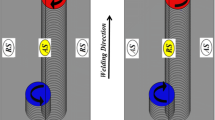Abstract
Welding is an extremely important joining method in the manufacturing process. For the last few years, the friction stir welding (FSW) method has significantly increased the quality of a weld. However, FSW has a slightly short research and application progress. The related applied experiences are not prevalent. Therefore, FSW has a lack of reference information on related welding applied design, such as fixture, joining, and integrated design. This article intends to combine innovative design methods in the application of FSW design. Additionally, this article establishes the applied design mode of FSW through case analysis to assist engineers or design personnel who are not familiar with the FSW process. This will help to decrease trial and error or failure risks in the welding process of fixture design. Encountered welding difficulties are thus solved after being guided by the theory of inventive problem solving (TRIZ) design method. By combining traditional TRIZ design methods, this article also refers to other TRIZ methods proposed by some scholars because work will often encounter various engineering challenges. This article hopes to provide welding design personnel with innovative design ideas under research and for practical application.
Similar content being viewed by others
References
Ungureanu CA, Das S, Jawahir IS (2007) Life-cycle cost analysis: aluminum versus steel in passenger cars. TMS Meeting, Aluminum Alloys for Transportation, Packaging, Aerospace and Other Applications, Florida, USA, pp 11–24
Miller WS, Zhuang L, Bottema J, Wittebrood AJ, Smet PD, Haszler A, Vieregge A (2000) Recent development in aluminum alloys for the automotive industry. Mater Sci Eng A 280(1):37–49. doi:10.1016/S0921-5093(99)00653-X
Saunders HL (1991) Welding aluminum: theory and practice. The Aluminum Association, USA
Thomas WM (1991) Friction stir butt welding. International Patent Application. PCT/GB92 Patent Application no. 9125978.8
Threadgill PL (1999) Friction stir welding-the state of the art. TWI Rep, UK
Bhide SR, Michaleris P, Posada M, Deloach J (2006) Comparison of Bucking distortion propensity for SAW, GMAW, and FSW. Weld J 85(9):189s–195s
Lim S, Kim S, Lee CG, Kim S (2004) Tensile behavior of friction-stir-welded Al 6061-T651. Metall Mater Trans A 35A(9):2829–2835. doi:10.1007/s11661-004-0230-5
Lee WB, Yeon YM, Hung SB (2004) Mechanical properties related to microstructural variation of 6061Al alloy joints by friction stir welding. Mater Trans 45(5):1700–1705
Zhang Z, Zhang HW (2007) Material behaviors and mechanical features in friction stir welding process. Int J Adv Manuf Technol 35(1–2):86–100. doi:10.1007/s00170-006-0707-z
Boz M, Kurt A (2004) The influence of stirrer geometry on bonding and mechanical properties in friction stir welding process. Mater Des 25(4):343–347. doi:10.1016/j.matdes.2003.11.005
Querin JA, Davis AM, Schneider JA (2007) Effect of processing parameters on microstructure of the FSW nugget. Friction Stir Welding and Processing IV, TMS, USA, pp 185–192
Hsieh HT, Chen JL (2008) Influence of welding parameters on mechanical properties of friction stir welded 6061-T6 launch box. Mater Trans 49(10):2179–218. doi::10.2320/matertrans.L-MRA2008829
Elangovan K, Balasubramanian V (2008) Influences of tool pin profile and tool shoulder diameter on the formation of friction stir processing zone in AA6061 aluminum alloy. Mater Des 29(2):362–373. doi:10.1016/j.matdes.2007.01.030
Elangovan K, Balasubramanian V, Valliappan M (2008) Influences of tool pin profile and axial force on the formation of friction stir processing zone in AA6061 aluminum alloy. Int J Adv Manuf Technol 38(3–4):285–295. doi:10.1007/s00170-007-1100-2
Friction stir welding: after a decade of development. Friction Stir Welding and Processing IV, TMS, USA, pp 3–18
Luan G, Lin S, Chai P, Li H (2004) Friction stir welding in large 6063Al extrusions manufacturing. 5th International FSW Symposium Session 08B, Metz, France
Colligan K, Ternan KM, Pickens JR (2001) FSW of thick section corner joints in aluminum alloys. 3rd International FSW Symposium Session 5, Kobe, Japan
Subramanian V, Senthil kumar A, Seow KC (1999) Conceptual design of fixtures using genetic algorithms. Int J Adv Manuf Technol 15(2):79–84. doi:10.1007/s001700050042
Li B, Shui BW, Lau KJ (2002) Fixture configuration design for sheet metal assembly with laser welding: a case study. Int J Adv Manuf Technol 19(7):501–509. doi:10.1007/s001700200053
Sun SH, Chen JL (1995) A modular fixture design system based on case-based reasoning. Int J Adv Manuf Technol 10(6):389–395. doi:10.1007/BF01179402
Altshuller GS, Shulyak L, Rodman S (1999) The innovation algorithm: TRIZ, systematic innovation and technical creativity. Technical Innovation Center Inc., Worcester
Li Y, Wang J, Li X, Zhao W (2007) Design creativity in product innovation. Int J Adv Manuf Technol 33(3–4):213–222. doi:10.1007/s00170-006-0457-y
Chang HT, Chen JL (2003) Eco-innovative examples for 40 TRIZ inventive principles. The TRIZ J, Aug 8. http://www.triz-journal.com/archives/2003/08/a/01.pdf
Kim IC (2005) 40 principles as a problem finder. The TRIZ J, March 4. http://www.triz-journal.com/archives/2005/03/04.pdf
Marsh DG, Waters FH, Marsh TD (2004) 40 Inventive principles with applications in education. The TRIZ J, April 4. http://www.triz-journal.com/archives/2004/04/04.pdf
Chen JL, Liu CC (2001) A TRIZ inventive product design method without contradiction information. The TRIZ J, Sept 6. http://www.triz-journal.com/archives/2001/09/f/index.htm
Mononen J, Siren M, Hanninen H (2001) Cost comparison of FSW and MIG welded aluminum panels. 3rd International FSW Symposium Session 8A, Kobe, Japan
Wood M, Larsson S, Dahlstrom H (2001) Environmental comparison of FSW against MIG in aluminum railway rolling stock. 3rd International FSW Symposium Session 8A, Kobe, Japan
Threadgill P, Russell M (2005) FSW train course. TWI, Beijing
Author information
Authors and Affiliations
Corresponding author
Rights and permissions
About this article
Cite this article
Hsieh, H.T., Chen, J.L. Using TRIZ methods in friction stir welding design. Int J Adv Manuf Technol 46, 1085–1102 (2010). https://doi.org/10.1007/s00170-009-2172-y
Received:
Accepted:
Published:
Issue Date:
DOI: https://doi.org/10.1007/s00170-009-2172-y




